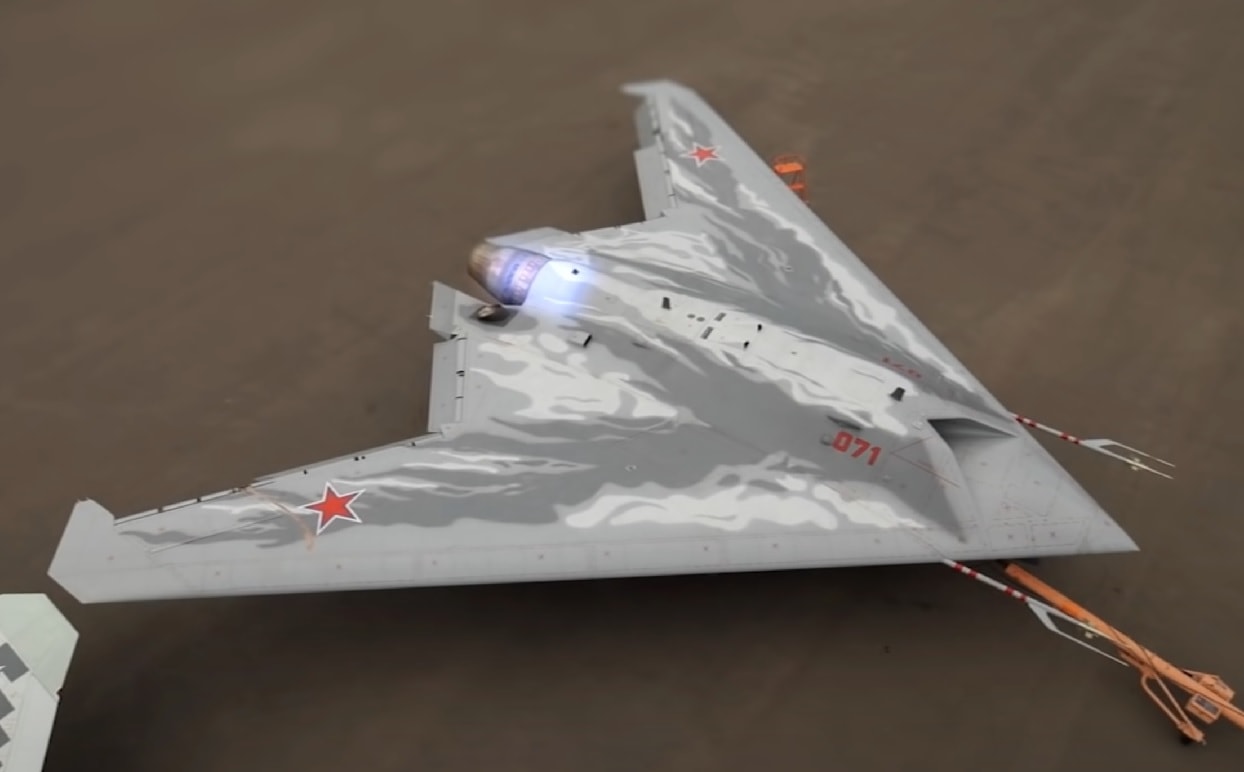S-70 Drone: What Should We Think? It seems like the “Loyal Wingman” concept is all the rage these days. The idea is to have a stealth fighter play the “quarterback” – and serve as the leader of up to four drones. These drones are attritable – meaning their loss is not as big a deal as having a manned fighter shot down. The unmanned “players” fly in a vanguard formation to conduct reconnaissance, execute electronic warfare and jamming, offer targeting data, perform bomb damage assessment, and deliver their own precision-guided munitions.
What Is Happening with the S-70 Okhotnik-B?
Playing loyal wingman for Russia is the stealth S-70 Okhotnik-B (“Hunter”) unmanned combat aerial vehicle. It serves the Su-57 fifth-generation stealth fighter. The Okhotnik-B is getting close to showing off its full combat abilities. It performed a test firing of precision-guided missiles at ground targets in late May. This was likely a GPS-guided Kh-59MK2 cruise missile that is also deployed with the Su-57. The missile test was announced by Russian state-run media, so all the caveats on propaganda apply, but it shows that Russia is serious about the potential manned/ unmanned teaming arrangement in combat.
Testing Different, Less Evolved Weapons
The news release claimed that the “device can effectively hit small-sized camouflaged targets with missiles at different times of day in any weather conditions.” It also said the Okhotnik-B had already dropped dumb bombs in previous evaluations dating back to January 2021. We also know that Okhotnik-B flew with simulated air-to-air missiles in 2020. This would mean it could also serve as a fighter-interceptor.
This Is a Heavy Drone Based on Earlier Designs
The combat drone has a flying wing design and is quite large, weighing in at 20 tons with a 46-foot wingspan. It is based on the MiG Skat combat drone that first made an appearance in 2007 during a test flight. The Skat, which was discontinued, though the technology likely transferred to the Okhotnik program, could fly at least 7,000 feet in elevation and 310 miles per hour.
Keeping Up with the Americans
The Okhotnik-B could be compared to the Boeing “Air Power Teaming System.” This is a combat drone that also plays a Loyal Wingman role. It features artificial intelligence for a greater force multiplier effect with an early warning system to “outthink” enemy fighters and incoming missiles. The Boeing drone is 38 feet long and can fly 2,300 miles.
Teaming Arrangement Probably Not Ready
The Okhotnik will likely enter service in 2024. But that doesn’t mean it will be fully integrated with the Su-57 in a teaming role right away. It will probably serve in only an individual ground-strike mode until the Loyal Wingman concept is fully in effect.
Are There Enough Resources for the S-70 Combat Drone?
Russia has many balls in the air when it comes to future weapons systems – hypersonic missiles, nuclear-powered and nuclear-tipped torpedoes, and new submarines. With all these programs and a raging war in Ukraine, can the Russian military-industrial complex bring the Okhotnik into serial production?
Vladimir Putin and his propaganda organs love to crow about new weapons programs echoed by television news commentators who make threats to Ukrainian allies. For example, a Russian talking head proclaimed that Russian weapons could “wipe Britain off the map.” So, these new arms programs have a psychological and political effect, even if they do not make it to full production. Still, we’re likely to see the Okhotnik-B flying in a teaming arrangement sometime this decade. The Loyal Wingman concept will be an important factor in Russian aerospace goals as it tries to match the United States in technological development.
Now serving as 1945’s Defense and National Security Editor, Brent M. Eastwood, PhD, is the author of Humans, Machines, and Data: Future Trends in Warfare. He is an Emerging Threats expert and former U.S. Army Infantry officer. You can follow him on Twitter @BMEastwood.

